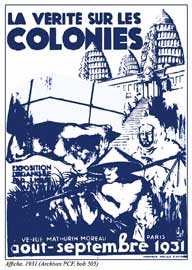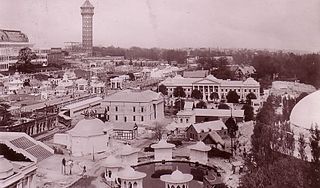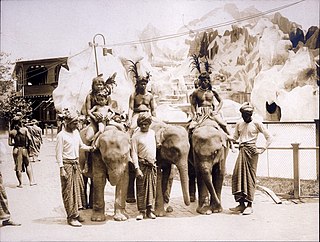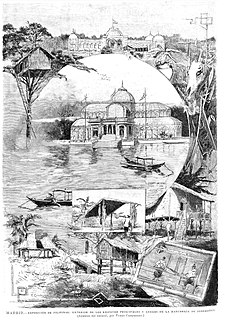 W
WA colonial exhibition was a type of international exhibition that was held to boost trade. During the 1880s and beyond, colonial exhibitions had the additional aim of bolstering popular support for the various colonial empires during the New Imperialism period, which included the scramble for Africa.
 W
WThe British Empire Exhibition was a colonial exhibition held at Wembley Park, Wembley, England, from 23 April 1924 to 31 October 1925.
 W
WThe Brussels International Exposition of 1910 was a World's fair held in Brussels, Belgium, from 23 April to 1 November 1910. This was just thirteen years after Brussels' previous World's fair. It received 13 million visitors, covered 88 hectares and lost 100,000 Belgian Francs.
 W
WThe Brussels International Exposition of 1897 was a World's fair held in Brussels, Belgium, from 10 May 1897 through 8 November 1897. There were 27 participating countries, and an estimated attendance of 7.8 million people.
 W
WThe Colonial and Indian Exhibition of 1886 was held in South Kensington in London with the objective to "stimulate commerce and strengthen the bonds of union now existing in every portion of her Majesty's Empire". The exhibition was opened by Queen Victoria, and when it closed had received 5.5 million visitors.
 W
WThe Colonial Exhibition, Dutch: Koloniale Tentoonstelling, took place in Semarang, Dutch East Indies in from August 13 through November 15, 1914. Colonial exhibitions were trade expositions. It was designed to "give a comprehensive picture of the Dutch Indies in their present prosperous condition."
 W
WThe Empire Exhibition, South Africa, held in Johannesburg, was intended to mark that city's jubilee and was opened by the Governor-General of the Union of South Africa on 15 September 1936. It was the first exhibition held in the Union of South Africa following two earlier exhibitions in Cape Colony in 1877 and 1892. The idea of an empire exhibition in South Africa was first discussed in 1934 by the Buy Empire Committee of Johannesburg. On 9 January 1935, the Grand Council of the Federation of British Industries passed a resolution for a proposal to hold an Empire Exhibition in Johannesburg in 1936 in conjunction with the Golden Jubilee of the city.
 W
WEmpire Exhibition, Scotland 1938 was an international exposition held at Bellahouston Park in Glasgow, from May to December 1938.
 W
WThe 1911 Festival of Empire was the biggest single event held at The Crystal Palace in London since its opening. It opened on 12 May and was one of the events to celebrate the coronation of King George V. The original intention had been that Edward VII would open it in 1910, however, this was postponed after his death shortly before the planned opening day. The Festival contained a display of landscapes and exhibits from the British Empire, mainly the dominion countries, to encourage emigration to those nations; and it contained a large scale pageant dramatising British history. It was described at the time as ‘a social gathering of the British family’ encouraging the ‘firmer welding of those invisible bonds which hold together the greatest empire the world has ever known’. It has since been described as the ‘ultimate imperialist propaganda showcase’.
 W
WThe Franco-British Exhibition was a large public fair held in London between 14 May and 31 October 1908. The exhibition attracted 8 million visitors and celebrated the Entente Cordiale signed in 1904 by the United Kingdom and France. The chief architect of the buildings was John Belcher.
 W
WHuman zoos, also known as ethnological expositions, were public displays of people, usually in an erroneously labeled "natural" or "primitive" state. They were most prominent during the 19th and 20th centuries. These displays often emphasized the supposed inferiority of the exhibits' culture, and implied the superiority of "Western society". Throughout their existence such exhibitions garnered controversy over their demeaning, derogatory, and dehumanizing nature. They began as a part of circuses and "freak shows" which displayed exotic humans in a manner akin to a caricature which exaggerated their differences. They then developed into independent displays emphasizing the exhibits' inferiority to western culture and providing further justification for their subjugation. Such displays featured in multiple World's fairs and then transitioned into sections of animal zoos.
 W
WA colonial exhibition was a type of international exhibition that was held to boost trade. During the 1880s and beyond, colonial exhibitions had the additional aim of bolstering popular support for the various colonial empires during the New Imperialism period, which included the scramble for Africa.
 W
WA colonial exhibition was a type of international exhibition that was held to boost trade. During the 1880s and beyond, colonial exhibitions had the additional aim of bolstering popular support for the various colonial empires during the New Imperialism period, which included the scramble for Africa.
 W
WA colonial exhibition was a type of international exhibition that was held to boost trade. During the 1880s and beyond, colonial exhibitions had the additional aim of bolstering popular support for the various colonial empires during the New Imperialism period, which included the scramble for Africa.
 W
WThe International Colonial and Export Exhibition was a colonial exhibition held in Amsterdam from May 1 to October 1, 1883. The event drew at least a million visitors and was the first international colonial exhibition, with 28 different nations presenting their colonial trade and wealth.
 W
WThe International exhibition of marine and maritime hygiene was a world's fair held in Genoa in 1914.
 W
WThe Paris Colonial Exhibition was a six-month colonial exhibition held in Paris, France, in 1931 that attempted to display the diverse cultures and immense resources of France's colonial possessions.
 W
WThe Philippines Exposition was a colonial exhibition held in El Retiro, Madrid, in 1887, in order to boost commercial and economic relations between the archipelago of the Philippines and the metropolis.
 W
WThe first Sydney Intercolonial Exhibition was a series of exhibitions inspired by the historic Great Exhibition held in London in 1851. The Colony of New South Wales mounted its first such exhibition in 1854 in preparation for the Paris Exhibition of 1855, another in 1861 in preparation for the London Exhibition of 1862, and then several more until being held annually throughout the 1870s under the name Metropolitan Intercolonial Exhibition.
 W
WThe Taiwan Exposition: In Commemoration of the First Forty Years of Colonial Rule was an exhibition held in Taihoku Prefecture in 1935, the 10th year of Hirohito's reign, to mark 40 years of the establishment of Japanese Formosa.